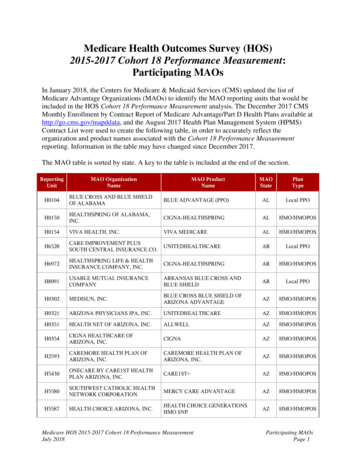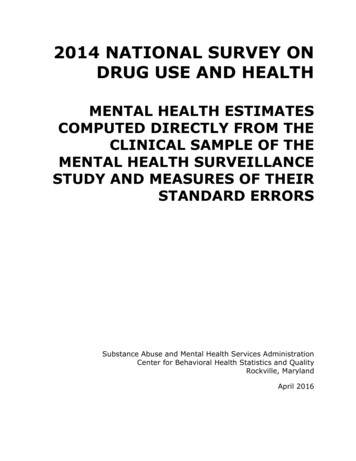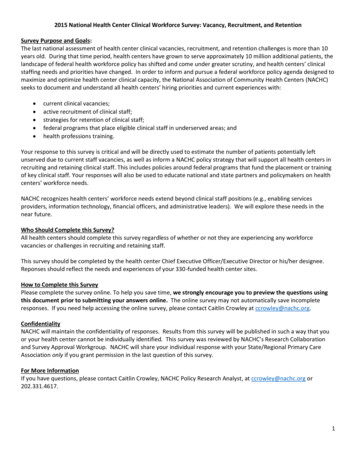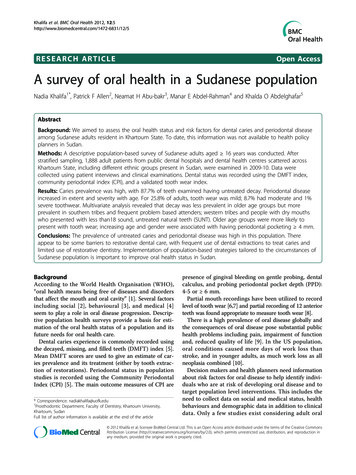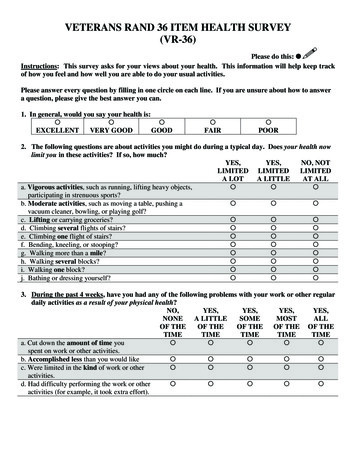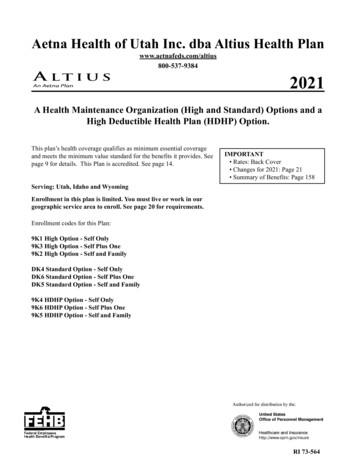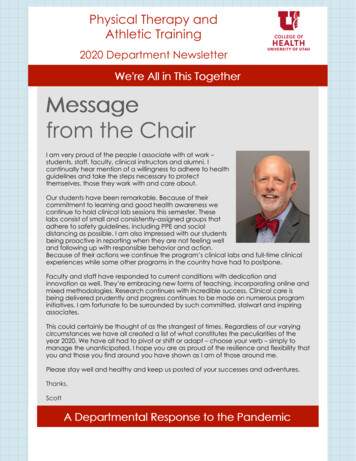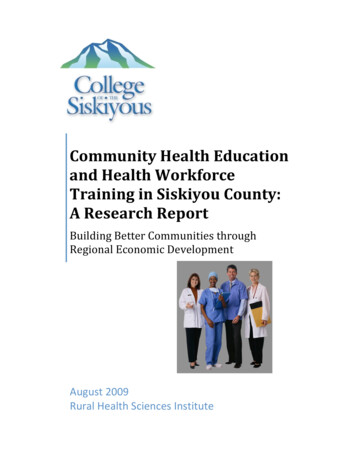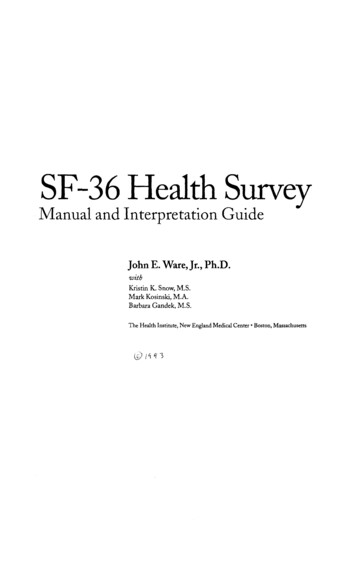
Transcription
SF-36 Health SurveyManual and Interpretation GuideJohn E. Ware, Jr., Ph.D.withKristin K. Snow, M.S.Mark Kosinski, M.A.Barbara Gandek, M. S.The Health Institute, New England Medical Center Boston, Massachusetts
This chapter provides scoring instructions for the eight multi-item scalesand for the reported health transition item included in the SF-36 HealthSurvey. Chapter 3 describes the SF-36 scales and items. General scoringinformation and steps for data entry and scoring that are common to all itemsare discussed first (see Figure 6.1). Next, formulas for item aggregation andtransformation of scale scores are presented. Finally, formal checks for errorsin scoring are explained.Importance of standardizationAs with all standardized tests, standardization of content and scoring is whatmakes interpretation of the SF-36 scales possible. The content of the SF36 form and the scoring algorithms were selected and standardized following careful study of many options. The algorithms described in this chapterwere chosen to be as simple as possible while still satisfying the assumptionsof the methods used to construct SF-36 scales.Changes in the content of the survey or in scoring algorithms may compromise the reliability and validity of scores. Changes are also likely to bias scoressufficiently to invalidate normative comparisons and to prevent comparisonsof results across studies.There are at least two good reasons to adhere to the standards of content andscoring described in this manual. First, they are most likely to produce scoreswith the same reliability and validity as those reported here and in otherMedical Outcomes Study (MOS) publications. Second, comparisons ofresults across studies are made possible to the benefit of all who use thesecontent and scoring standards.Prior to using the SF-36 scoring rules, it is essential to verify that the questionnaires being scored, including the questions asked (item stems), responsechoices, and numbers assigned to response choices at the time of data entry,have been reproduced exactly. The scoring rules described in this chapter are
6:2----------------.-SF-36 Health Survey Manual--- -Enter dataFLG\4 'C H . 1 R T F O R5 C O R i N G T H E SF-36'I!Recode out-of-range item values as missingReverse score and/or recalibrate scores for 10 itemsII//Recode missing item responses with mean substitution(where warranted)Compute raw scale scores1Transform raw scale scores to 0-100 scaleIPerform scoring checks
Scoring the SF-366:3appropriate for the standard SF-36 survey questions, response choices, andnumbers assigned to response choices as reproduced in Appendix B. T h echapter ends with algorithms that help to equate scores for the Developmentalversion and the Standard version of the SF-36.General scoring informationSF-36 items and scales are scored so that a higher score indicates a betterhealth state. For example, functioning scales are scored so that a high scoreindicates better functioning and the pain scale is scored so that a high scoreindicates freedom from pain. After data entry, items and scales are scored inthree steps:(1) item recoding, for the 10 items that require recoding;(2) computing scale scores by summing across items in the samescale (raw scale scores); and(3) transforming raw scale scores to a 0 - 100 scale (transformedscale scores).We recommend that both item recoding and scale scoring be performed bycomputer, using the scoring algorithms documented here or computer software available elsewhere (THI, 1992).Data EntryThe SF-36 item responses should be keypunched as coded in the questionnaire. It is important to note that, although the numbers printed along withthe response choices should be keypunched, they may not be the numbersultimately assigned to those responses when SF-36 scales are scored.In most cases, this means that the precoded number that is circled or markedby the respondent should be entered. However, sometimes it is not clearwhat number should be entered. Suggested rules for handling some of themore common coding problems are:If a respondent marks two responses which are adjacent toeach other, randomly pick one and enter that number.
6:4SF-36 Health Survev ManualIf a respondent marks two responses for an item and they arenot adjacent to each other, code that item "missing."If a respondent marks three or more responses for an item,code that item "missing."If a respondent answers the "yes/no7'items by writing in "yes"or "no," code the answer as though "yes" or "no" had beenmarked.Response Technologies Inc. and other companies have developed scanningforms for use with the SF-36, in both standard and acute formats. Sampleforms appear in Appendix B. Optical scanning generally reduces the timerequired to process questionnaires, but may involve greater initial investmentin form design. Some scanning forms may require special processing equipment; however, this method may be cost-effective, especially if the SF-36 isbeing administered frequently or to a large sample (see Chapter 12).Tables 6.1 through 6.9 present scoring information for the items used ineach of the eight SF-36 health scales and the reported health transition item.Each table presents the verbatim content of each question, response choices,and both the precoded values printed in the questionnaire and final valuesfor scoring each item. Item numbers in Tables 6.1 through 6.9 correspondto those on the Standard SF-36 form (reproduced in Appendix B).T h e next stage after data entry is the recoding of response choices as shownin Tables 6.1 through 6.9. Item recoding is the process of deriving the itemvalues that will be used to calculate the scale scores. Several steps are includedin this process: (1) change out-of-range values to missing, (2) recode valuesfor 10 items, and (3) substitute person-specific estimates for missing items.-,-.,--. .,.,- -:.-. - . .' : , : . . 2 . All 36 items should be checked for out-of-range values prior to assigningthe final item values. Out-of-range values are those that are lower than a1 Iitem's precoded minimum value or higher than an item's precoded maximull Ivalue (see Tables 6.1 through 6.9). Out-of-range values are usually causcclby data-entry errors and, if possible, should be changed to the correct response.through verification with the original questionnaire. If the questionnaire i .not available, all out-of-range values should be recoded as missing data.
Scoring the SF-36Verbatim Items3a.Vigorous activities, such as running, lifting heavy objects, participating in strenuoussports3b.Moderate activities, such as moving a table, pushing a vacuum cleaner, bowling, orplaying golf3c.Lifting or carrying groceries3d.Climbing several flights of stairs3e.Climbing one flight of stairs3f.Bending, kneeling, or stooping3g.3h.Walking more than a mile3i.Walking one block3j.Bathing or dressing yourselfWalking several blocksPrecoded and Final Values for Items 3a - 3jResponse ChoicesYes, limited a lotPrecoded ItemValue Final Item Value11Yes, limited a little22No. not limited at all33Scale ScoringCompute the simple algebraic sum of the final item scores as shown in Table 6.11. See textfor handling of missing item responses. This scale is scored so that a high score indicatesbetter physical functioning.Note. Precoded values are as shown on the appended form. This scale does not require recoding of itemsprior to computation of the scale score.
6:6S F 3 6 Health Survev ManualTABLE6.2ROLE-PHYSICAL: VERBATIM I T E M S A N D S C O R I N GINFORMATIONVerbatim Items4a.Cut down the amount of time you spent on work or other activities4b.Accomplished less than you would like4c.Were limited in the kind of work or other activities4d.Had diBculty performing the work or other activities (for example, it took extra effort). . , . ., . . . . .,. ., . . ., . ., ., ., ,. . . ., . ., . . ., ., . . . .Precoded and Final Values for Items 4a - 4dPrecoded Item ValueFinal Item ValueYesResponse Choices11No22Scale ScoringCompute the simple algebraic sum of the final item values as shown in Table 6.11. See textfor handling of missing item responses. This scale is scored so that a high score indicatesbetter Role-Physical functioning.Note. Precoded values are as shown on the appended form. This scale does not require recoding of itemsprior to computation of the scale score.
Scoring the SF-366:7--Verbatim Items7.How much bodily pain have you had during the past 4 weeks?8.During the past 4 weeks, how much did pain interfere with your normal work (including both work outside the home and housework)?Precoded and Final Values for Item 7Response Choices--Preceded Item ValueFinal Item ValueNone16.0Very mild25.4Mild34.2Moderate43.1Severe52.2Very severe61.0Scoring for Item 8ResponseChoices- if both Items 7 and 8 are answeredItem 7Item 8If Item 8Precoded Item Value and Precoded Item Value then Final Item ValueNot at all116Not at all12 through 65A little bit21 through 64Moderately31through 63Quite a bit41through 62Extremely51 through 61Scoring for Item 8 -if Item 7 is not answeredResponse ChoicesPrecoded Item ValueFinal Item ValueNot at all16.0A little bit24.75Moderately33.5Quite a bit42.25Extremely51.OScale ScoringCompute the simple algebraic sum of final item values as shown in Table 6.11. See text forhandling of missing item responses. This scale is scored positively so that a high score indicates lack of bodily pain.Note. Precoded values are as shown on the appended form. This scale requires recoding of both itemsprior to computation ofthe scale score.
-TABLE6.4S F 3 6 Health Survey ManualG E N E R A L HEALTH: VERBATIM ITEMS A N D S C O R I N GINFORMATIONdVerbatim Items1.I n general, would you say your health is:l l a . I seem to get sick a little easier than other people1l l b . I am as healthy as anybody I knowdl l c . I expect my health to get worse4l l d . My health is excellentPrecoded and Find Values for Items 1 & l l a - l l d4Item 1Response ChoicesExcellentPrecoded Item Value Final Item Value15.0Very goodAaGoodFairPoorItems l l a & l l cItems l l b & l l dResponse ChoicesPrecoded Item Value Final Item ValueDefinitely True11Mostly True22Don't Know33Mostly False4Definitely False5Response Choices 1i1Precoded Item Value Final Item ValueDefinitely True15Mostly True24Don't Know3Mostly False4Definitely False5izScale ScoringCompute the simple algebraic sum of the final item values as shown in Table 6.11. See textfor ha.ndling missing item responses. This scale is scored so that a high score indicatesbetter general ealth Pelrceptions.--Note. Precoded values are as shown on the appended form. This scale requires recoding of three itemsprior to computation of the scale score. 8
Scoring tAe SF-366:9----Verbatim Items9a.Did you feel full of pep?9e.Did you have a lot of energy?9g.Did you feel worn out?9i.Did you feel tired?Precoded and Final Values for Items 9a, 9e, 9g, & 9iItems 9a &9eResponse ChoicesItems 9g & 9iPrecoded Item ValueFinal Item ValueAll of the time16Most of the time25A good bit of the time3Some of the time4A little of the time5None of the time61Precoded Item ValueFinalItem Value-Response Choices-All of the time11Most of the time22A good bit of the time33Some of the time44A little of the time55None of the time66-.Scale ScoringCompute the simple algebraic sum of the final item values as shown in Table 6.11. See textfor handling of missing item responses. This scale is scored so that a high score indicatesmore vitality.Note. Prewded values are as shown on the appended form. This scale requires recodng of two itemsprior to computation of the scale score.
TABLE6.6S O C I A L F U N C T I O N I N G : VERBATIM ITEMS A N D S C O R I N GINFORMATIONVerbatim ItemsDuring the past 4 weeks, to what extent has your physical health or emotional problems interfered with your normal social activities with family, friends, neighbors, orgroups?During the past 4 weeks, how much of the time has your physical health or emotionalproblems interfered with your social activities (like visiting with friends, relatives, etc.)?Precoded and Final Values for Items 6 & 10Item 6Response ChoicesPrecoded Item Value-Not at allFinalItem Value-15Moderately33Quite a bit42Extremely51Precoded Item ValueFinal Item ValueAll of the time11Most of the time22Some of the time33A little of the time44None of the time55SlightlyItem 10 Response ChoicesScale ScoringCompute the simple algebraic sum of the final item values as shown in Table 6.11. See textfor handling of missing item responses. This scale is scored so that a high score indicatesbetter social functioning.Note. Precoded values are as shown on the appended form. This scale requires recoding of one itemprior to computation of the scale score.
6:11Scoring the SF-36TABLE6.7R O L E - E M O T I O N A L : VERBATIM I T E M S A N D S C O R I N GINFORMATIONVerbatim Items5a.Cut down the amount oftime you spent on work or other activities5b.Accomplished less than you would like5c.Didn't do work or other activities as carefully as usualPrecoded and Final Values for Items 5a - 5cPrecoded Item ValueFinal Item ValueYesResponse Choices11No22Scale ScoringCompute the simple algebraic sum of the final item values as shown in Table 6.11. See textfor handling of missing item responses. This scale is scored so that a high score indicatesbetter Role-Emotional functioning.Note. Precoded values are as shown on the appended form. This scale does not require recoding of itemsprior to computation of the scale score.
6:12--- -----------SF-36 Health Survey Manual-.-- .- - -.-- --Verbatim ItemsYb.Have you been a very nervous person?Yc.Have you felt so down in the dumps that nothing could cheer you up?9d.Have you felt calm and peaceful?Yf.Have you felt downhearted and blue?Yh.Have you been a happy person?recoded and Final Tidues fol Items 9b, 9c, 9d, 9f: & 9hitems 9b, 9c, & 9fResponseCiioices.-. Precoded Item ValueFinal Item ValueAll of the time11ATosr ofthe time224 good bit of the time33Soine of the time44A little of the time55None ofthe time66Precoded Item Value--Itens 9d &9hC!wicesA1 of the time1FinalItemValue---6&lost of the time25A ROOcl hit of the time34Some oithe time43A little of the time52None of the time61R l y ( 1 i i ----Scale ScoringCompute the simple algebraic sum of the final item values as shown in Table 6.11. See thetext for handling of missing item responses. This scale is scored so that a high score indicatesbetter mental health.Note. Precoded values are as shown on the appended form. This scale requires recoding of two itemsprior to computation of the scale score.
Scorina the SF-366:13TABLE6.9R E P O R T E D H E A L T H T R A N S I T I O N : VERBATIM I T E M A N DSCORING I N F O R M A T I O NVerbatim Item2.Compared t o one year ago, how would you rate your health i n general now?Precoded and Final Values for Item 2Response ChoicesPrecoded Item ValueMuch better now than one year ago1Somewhat better now than one year ago2About the same as one year agoSomewhat worse now than one year agoMuch worse now than one year ago5Note. Precoded item values are as shown on the appended form. The average measured change in healthfor respondents selecting each response choice is presented in Chapter 9.
--S F 3 6 Health Survey ManualRecode Valuesfor 10 ItemsSeven items are reverse scored. Reverse scoring of items is done to ensurethat a higher item value indicates better health on all SF-36 items and scales.SF-36 items that need to be reverse scored are worded so that a higherprecoded item value indicates a poorer health state.I t e m RecalibrationFor 34 of the SF-36 items, research to date offers good support for theassumption of a linear relationship between item scores and the underlyinghealth concept defined by their scales. However, empirical work has shownthat two items require recalibration to satisfy this important scaling assumption. These items are in two different SF-36 scales: the General Health(GH) scale and the Bodily Pain (BP) scale.General Health Rating Item. The "Very Good" and "Good" responses toItem 1 are recalibrated to achieve a better linear fit with the general healthevaluation concept measured by the GH scale. Empirical studies during theHealth Insurance Experiment (HIE) were among the first to document thatthe intervals between response choices for this item are not equal (Davies &Ware, 1981). Subsequent studies of Item 1,using both the Thurstone Methodof Equal-Appearing Intervals (Thurstone & Chave, 1929) and other empirical methods, have also consistently shown that the interval between"Excellent" and "Very Good" is about half the size of the interval between"Fairn and "Good" (Ware, Nelson et al., 1992). These results have beenconfirmed in studies of SF-36 translations from 10 countries participatingin the International Quality of Life Assessment (IQOLA) Project. Finally,in all studies we are aware of to date, mean values for a criterion generalhealth scale for respondents who choose each of the five levels defined byItem 1depart significantly from linearity.Results from two MOS studies that served as the basis for the recommendedrecalibration of Item 1 are summarized in Table 6.10. As shown in Table6.10 and discussed elsewhere (Ware, Nelson, et al., 1992), the mean criterion scores were remarkably similar for those who chose the same categoryof Item 1 across the screening (N 18,573) and longitudinal (N 3,054)samples. Intervals between adjacent response categories were unequal, asobserved in the HIE (Davies &Ware, 1981). For these reasons, item scalevalues are transformed as shown in Table 6.10 using specific results from the
Mean Current HealthRecommended Scoring1-5 ScaleC-100 ple(N 18,573)(N 3,054)Excellent87.9Very goodGoodResponse toItem 1Note. Adapted from "Preliminarytests of a 6-item general health survey: A patient application"by J.E. Ware, E.C. Nelson et al., 1992, in A.L. Stewart &J.E. Ware (Eds.), Measun'n&nctioning and well-being: The Medical Outcomes Study approach (p. 299). Durham, NC: DukeUniversity Press.screening sample. The result is a very high 0.70 correlation with the sum ofthe other four items in the GH scale.Bodily Pain Items. The scoring rules recommended for the Bodily Pain(BP) scale were based on three considerations: (1)the items offer both different numbers and different content of response choices, (2) administrationof Item 8 depended on the response to an item like Item 7 in the MOS, and(3) empirical studies indicate that recalibration of Item 7 is necessary toachieve a linear fit with the scale score and with other measures of bodilypain.As shown in Table 6.3, the two bodily pain items offer an unequal numberof response choices (six for Item 7 and five for Item 8). As a result, their variances are not equal, as required for a summated rating scale. Further, in allM O S studies published to date, Item 8 was administered (following a skippattern) only to those respondents reporting at least some pain. Althoughthe M O S skip pattern has been dropped to make the SF-36 easier to administer, the dependence between responses must be taken into account tocompare results from new studies with published studies.The recommended recoding of the first response choice for Item 8 on thebasis of the response to Item 7 solves two problems. First, it converts Item
SF-36 Health Survey Manual8 to a six-level item of roughly equal variance to Item 7. This is done by splitting those free of role interference due to pain into two different groups: (1)free of interference and free of pain (the best level), and (2) free of interference but with at least some pain (the next best level). Second, it approximates the dependence between the two items in MOS studies of reliabilityand validity to date (
SF-36 Health Survey Manual and Interpretation Guide John E. Ware, Jr., Ph.D. with Kristin K. Snow, M.S. Mark Kosi

